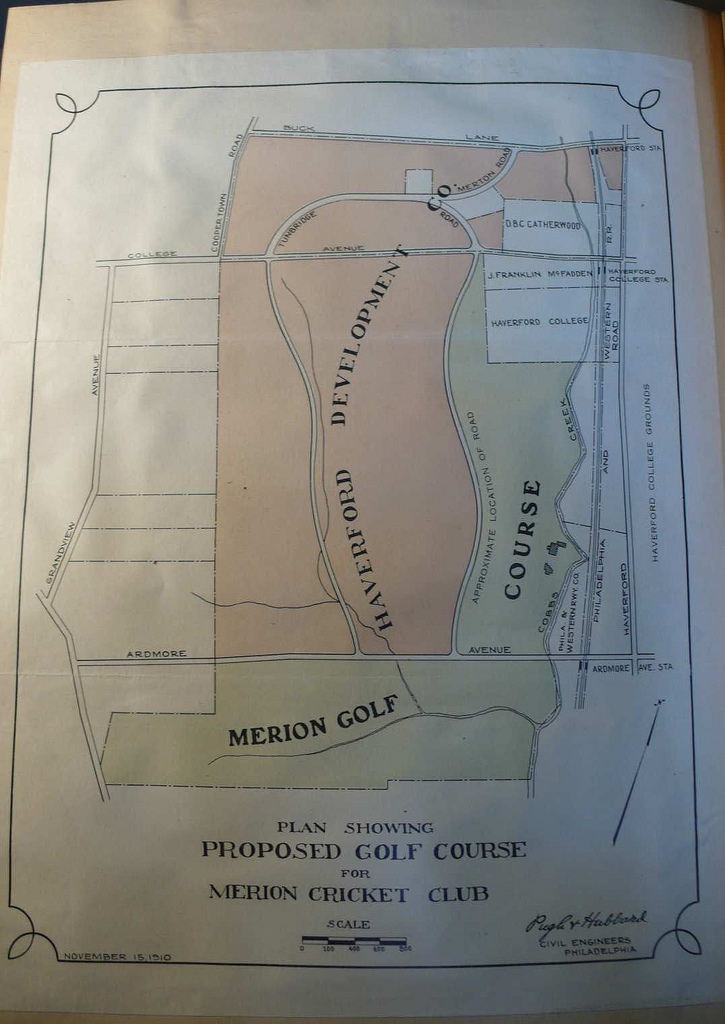On July 1, 1910, two days after Macdonald and Whigham visited the proposed site of the Merion course, and three weeks after a visit by HH Barker, the Site Committee sent the following Report (2 pages) to the Merion Board of Government;


Again, for posterity's sake, this is the contents of the "Macdonald Letter" to the Site Committee;
New York, June 29, 1910
Horatio G. Lloyd, Esq.
c/o Messrs. Drexel and Co.
Philadelphia, Pa
Dear Mr. Lloyd:
Mr. Whigham and I discussed the various merits of the land you propose buying, and we think it has some very desirable features. The quarry and the brooks can be made much of. What it lacks in abrupt mounds can be largely rectified.
We both think that your soil will produce a firm and durable turf through the fair green quickly. The putting greens of course will need special treatment, as the grasses are much finer.
The most difficult problem you have to contend with is to get in eighteen holes that will be first class in the acreage you propose buying. So far as we can judge, without a contour map before us, we are of the opinion that it can be done, provided you get a little more land near where you propose making your Club House. The opinon that a long course is always the best course has been exploded. A 6000 yd. course can be made really first class, and to my mind it is more desirable than a 6300 or a 6400 yd. course, particularly where the roll of the ball will not be long, because you cannot help with the soil you have on that property having heavy turf. Of course it would be very fast when the summer baked it well.
The following is my idea of a 6000 yard course:
One 130 yard hole
One 160 "
One 190 "
One 220 yard to 240 yard hole,
One 500 yard hole,
Six 300 to 340 yard holes,
Five 360 to 420 "
Two 440 to 480 "
As regards drainage and treatment of soil, I think it would be wise for your Committee to confer with the Baltusrol Committee. They had a very difficult drainage problem. You have a very simple one. Their drainage opinions will be valuable to you. Further, I think their soil is very similar to yours, and it might be wise to learn from them the grasses that have proved most satisfactory though the fair green.
In the meantime, it will do no harm to cut a sod or two and send it to Washington for anlaysis of the natural grasses, those indigenous to the soil.
We enjoyed our trip to Philadelphia very much, and were very pleased to meet your Committee.
With kindest regards to you all, believe me,
Yours very truly,
(signed) Charles B. Macdonald
In soil analysis have the expert note particularly amount of carbonate of lime. It should be noted that at this time, Merion and HDC were still many months away from aquiring the Dallas Estate, sale of which went through in November, 1910.
What HDC did have at this time (July 1910) is the Johson Farm, and properties west and north of it above Ardmore Avenue. Not coincidentally, as shown earlier, the acreage of the Johnson Farm sections south of Ardmore Avenue and the northeast section totalled 117 acres and this is the land inspected at that time by Barker, Macdonald, and Whigham. The latter two recommended the additional purchase of the 3 acres owned by the Railroad next to the clubhouse, which would have totalled 120. This land was later leased from the railroad for over 50 years.
One can see what the HDC holdings were in July 1910 both in the black marked section of Johson Farm (117 acres), as well as the sections west and north of the course (which goes further north off the map). Again, the Johnson Farm in black is the land looked at by Barker, Macdonald, and Whigham.

On November 15, 1910 along with the Land Plan, the following letter was sent to the membership of Merion.


The 117 acres at this point was no longer made up of just the northeastern and southern sections of the Johnson Farm.
Now, the 21 acre Dallas Estate had been purchased, and the land boundary between real estate and golf course in the northeastern section of the Johnson Farm had been "approximated" by a separating road boundary, which moved most of that boundary slightly east and created a net loss of 21 acres in that section of the course from what was proposed in July.
Given the net effect of the aquisition of the Dallas Estate and the delineation of the proposed road was +-0 acres, however, the totals remained 221 acres for real estate, 117 for golf course.
The Land Plan was attached, showing both the newly aquired Dallas Estate in the southwest corner, as well as the newly negotiated proposed boundary cutting up through the original northeast section of Johnson Farm, titled "Approximate Location of Road"
